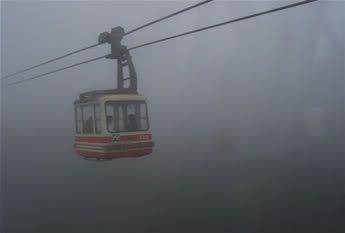A cable car looms out of the mist
As I mentioned previously, the Japanese are justifiably proud of their transport system. Once you can work out where you want to go, the journey is always accurate and on time. You just have to look at a station platform to see the pleasure Japanese take from the sheer act of travelling (I mean day trippers here - commuters in Japan are like commuters pretty much everywhere). Lined up at the appropriate spot for their seat allocation, clutching bento boxes and weak cold tea drinks, the respect they have for their transit systems is in marked contrast to those of UK travellers - they really have a sense of pride in their railways, for instance. As a result, the journey can seem as enjoyable as reaching the destination - they really are great travellers. With this in mind, Japanese transport companies (and there are many) have come up with special ways for their customers to travel. Things like super executive coaches cruise the roads, 'Romance Cars' give lucky passengers a driver's-eye view of the railway, and there are special circular routes that give views of a large natural attraction (like Mount Fuji) from a number of different forms of transport.
Dad doing a crossword on the cloudy cable car
The last one of those is one that we indulged in. We bought a 'Hakone Free Pass' - which despite the name cost Y5,500 (GBP27). This gave us unlimited hop on-hop off use of eight different kinds of public transport running in a circular loop near Mount Fuji, that took a whopping 11hrs to complete. We started at Shinjuku, and spent two hours on a rattling commuter train to the small town of Hakone-Yumoto. The actual Hakone loop started there, so really the ride from Shinjuku was an extra (if you like commuter trains). At Hakone-Yumoto we changed to the Tozan train - a steep three-carriaged tram that rumbled slowly up the hill. Apparently this stage of the journey was full of wonderful forest and mountain views - but the whole vista was hidden in a thick layer of grey cloud, so we couldn't see anything apart from a few trees. At Gora we changed again onto what the Japanese call a cable-car, but we would call a funicular railway. This took 9mins to ascend the hill, where we got on a ropeway (cable car) for thirty minutes. That's a long time to spend on a cable car - but halfway along at the high point of the mountain voyage (Owakudani) we had to get onto a smaller cable car and trundle along again.
Waiting in the rain to board the pirate ship
By this time the cloud had become all-enveloping, so we sailed through a cloud that was grey in every direction, like being inside a dull bubble - with no idea of the views we were missing. Actually that's not strictly true, as at every stop we saw magnificent posters of the very same cable car cruising past picture-postcard views of Mount Fuji, and Alpine-esque views. We had to be content with seeing Fuji-san this way, as we could have been pulled along within inches and not seen it. At the end of the cable-car section we transferred onto - of course - a pirate ship, and set off on a jaunty 30min cruise down Lake Ashi - again, shrouded in cloud and rain. Still, it was a pirate ship, at least. At the end of the Lake was a bus waiting to transfer us back to Hakone-Yumoto and the 'Romance Car'.
The Odakyu 'Romance Car'
Yes, the thought of another two hours in the commuter train gave us the idea of upgrading to the 'Romance Car' and zipping back to Shinjuku in style. I'm still not exactly sure what is romantic about it - but the driver sits upstairs at the front in a Boeing 747-esque cockpit, leaving the front of the train un-obscured for the passengers lucky enough to be sitting in the glass-enclosed nosecone. Amazingly, we were some of those lucky people, and spent a fun hour and a half looking out of the front and imagining what it would be like to drive. This is the appeal for the Japanese, of course - and helps explain why train-driving simulations are one of the most popular computer games series here. It goes back to that love of travel - it's the same reason why train staff are immaculately presented and have a genuine pride in what they do. When the system runs that well, it's only natural for the people that use it to enjoy it also - no matter where they go. That rubbed off on us, too. For although we essentially spent 11hrs on a moving conveyor belt and saw next to nothing of what we came to see - we still enjoyed it. It was because the Japanese were enjoying it, they came for the ride as much as the views - and who were we to disagree?